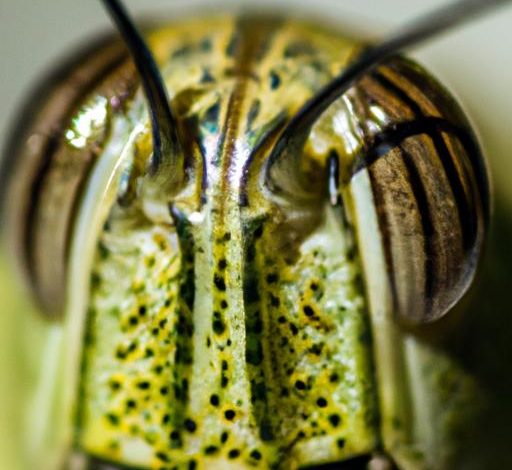Can Grasshoppers See: Unveiling the Wonders of Their Vision

Grasshoppers, those fascinating insects that gracefully leap and flutter through our gardens, have always intrigued us. As we observe their agile movements, we can’t help but wonder, can grasshoppers see? Delving into the intricacies of their vision opens up a world of wonder and sheds light on their astonishing abilities. In this article, we will explore the fascinating realm of grasshopper vision and understand why comprehending their sight is of utmost importance.
Understanding how grasshoppers see allows us to gain insight into their behavior, survival strategies, and ecological roles. These remarkable creatures possess a visual system that is uniquely adapted to their needs. By unraveling the mysteries of their vision, we can better understand their perception of the world around them.
Grasshoppers’ eyes are an intriguing aspect of their visual system. They possess compound eyes, which consist of thousands of tiny lenses known as ommatidia. This intricate eye structure grants them a panoramic view of their surroundings, enabling them to detect even the slightest movements. But what else can grasshoppers perceive? Can they see colors? Do they have sharp vision like humans? These questions pique our curiosity and necessitate further exploration.
As we embark on this journey through the realm of grasshopper vision, we will delve into their eye structure, uncover the mechanisms that enable them to perceive motion and colors, and explore the various factors that influence their visual capabilities. From the impact of external factors like light intensity and environmental conditions to internal factors such as age and health, we will unlock the secrets behind these fascinating creatures’ visual acuity.
Join me on this captivating adventure into the world of grasshopper vision. Let’s uncover the marvels of their sight and gain a deeper appreciation for these remarkable insects. Together, we will unravel the mysteries and unlock the wonders of how grasshoppers see.
Stay tuned for the next section, where we will dive into the intricacies of grasshopper eye structure and unravel the secrets behind their visual prowess.
Grasshopper Vision: An Overview
Grasshoppers, with their mesmerizing leaps and graceful movements, rely on their remarkable visual system to navigate their surroundings. In this section, we will delve into an overview of grasshopper vision, exploring the key components that contribute to their visual acuity.
A Glimpse into the Grasshopper’s Visual System
Grasshoppers possess a unique visual system that sets them apart from other insects. Their eyes are composed of compound eyes, which consist of numerous tiny lenses known as ommatidia. This compound eye structure allows grasshoppers to have a wide field of view, enabling them to detect potential threats or opportunities in their environment.
The Role of Compound Eyes
The compound eyes of grasshoppers play a vital role in their perception of motion. Each ommatidium captures a small portion of the visual field, and together, they create a mosaic-like image of their surroundings. This intricate arrangement allows grasshoppers to detect even the slightest movements, making them highly responsive to changes in their environment.
Specialized Visual Components
Within the compound eyes, grasshoppers possess specialized visual components that further enhance their visual capabilities. One such component is the cornea, which acts as the outer layer of the eye and plays a crucial role in focusing light onto the ommatidia. The retina, located at the back of the eye, contains light-sensitive cells that convert incoming light into electrical signals, facilitating visual perception.
Sensing Ultraviolet Light
Interestingly, grasshoppers have the ability to perceive ultraviolet (UV) light, which is invisible to the human eye. This exceptional capability allows them to differentiate between various objects and aids in their detection of potential mates, predators, or suitable habitats.
By understanding the fundamental aspects of grasshopper vision, we gain valuable insights into their unique visual system. In the next section, we will explore the intricate eye structure of grasshoppers, shedding light on the different types of eyes they possess and the functions they serve. Join me as we unravel the wonders concealed within the grasshopper’s eyes.
Grasshopper Eye Structure
Grasshoppers possess a unique and fascinating eye structure that sets them apart from other insects. Their eyes consist of compound eyes, which are made up of numerous individual lenses called ommatidia. This compound eye structure allows them to have a wide field of vision, enabling them to detect movement in their surroundings more effectively.
Compound Eyes: A Panoramic View
The compound eyes of grasshoppers are composed of thousands of ommatidia, each acting as a separate visual unit. These ommatidia work together to form a mosaic-like image, providing the grasshopper with a panoramic view. This wide field of vision allows them to detect predators, locate mates, and identify potential food sources.
Types of Eyes and Their Functions
Grasshoppers possess different types of eyes, each serving a specific function in their visual perception.
Large Compound Eyes
The primary eyes of grasshoppers are their large compound eyes located on the sides of their head. These eyes provide a broad view of the environment, allowing them to detect movement and navigate their surroundings effectively. The large compound eyes also play a crucial role in predator detection, enabling grasshoppers to quickly respond to potential threats.
Simple Eyes (Ocelli)
In addition to their compound eyes, grasshoppers also have simple eyes, known as ocelli, located on the top of their head. These ocelli are typically smaller than the compound eyes and are sensitive to light intensity and direction. While the ocelli do not provide detailed vision, they help grasshoppers orient themselves towards light sources, aiding in navigation and maintaining proper body temperature.
Understanding the intricate eye structure of grasshoppers allows us to comprehend their visual capabilities better. The compound eyes provide them with a wide field of vision, while the simple eyes help them navigate and respond to changes in light. In the next section, we will dive deeper into the mechanisms behind grasshopper vision, exploring how they perceive motion and detect colors. Stay tuned for an enlightening journey into the visual world of grasshoppers!
Grasshopper Vision Mechanisms
Grasshoppers, with their extraordinary visual capabilities, rely on intricate mechanisms to make sense of the world around them. Let’s delve into the fascinating visual mechanisms utilized by these remarkable insects and explore their ability to perceive motion and detect colors.
Sensing Motion: A Grasshopper’s Visual Superpower
Grasshoppers possess an exceptional ability to detect even the slightest movements in their environment. This is crucial for their survival as it helps them evade predators and navigate their surroundings effectively. The key to their motion-sensing prowess lies in their compound eyes and the specialized neurons that process visual information.
Within their compound eyes, grasshoppers have individual ommatidia, each containing a lens and photoreceptor cells. These photoreceptor cells, known as photoreceptor neurons, are responsible for converting light into electrical signals that the grasshopper’s brain can interpret. When an object moves across a grasshopper’s field of view, the motion is detected by specific neurons that respond to changes in visual stimulThis allows the grasshopper to swiftly react and adjust its movements accordingly.
Unveiling the Color Vision of Grasshoppers
While we often associate color vision with mammals and birds, grasshoppers also possess the ability to perceive colors, albeit in a different way. Their color vision is based on specialized photoreceptor cells called chromatic photoreceptors, which are sensitive to certain wavelengths of light.
Grasshoppers have been found to be particularly sensitive to ultraviolet (UV) light, which is beyond the range of human vision. This unique sensitivity allows them to perceive a broader spectrum of colors, including shades that are invisible to us. It is believed that their UV sensitivity plays a vital role in various aspects of their lives, such as finding mates, identifying suitable habitat, and detecting food sources.
By combining their motion-sensing abilities with their perception of colors, grasshoppers possess a remarkable visual system that helps them navigate their environment with precision and efficiency.
Stay tuned for the next section, where we will explore the factors that influence grasshopper vision, both externally and internally. Let’s uncover the intricate balance that determines the extent of their visual acuity.
Factors Affecting Grasshopper Vision
Grasshoppers, like any living beings, are influenced by various factors that can affect their vision. Understanding these factors is crucial in comprehending the nuances of their visual capabilities. Let’s explore the different elements that impact how grasshoppers see.
External Factors
External factors play a significant role in shaping grasshoppers’ visual perception. One of the key external factors is light intensity. These insects are highly sensitive to changes in light, and variations in intensity can have a profound effect on their ability to see. Bright light can enhance their visual acuity, allowing them to detect motion and distinguish colors more effectively. On the other hand, low light conditions may impair their vision, making it more challenging for them to navigate their surroundings.
Environmental conditions also impact grasshopper vision. For instance, grasshoppers in dense vegetation may have limited visibility due to obstructed views. Additionally, environmental factors such as humidity, temperature, and atmospheric conditions can influence how well grasshoppers see. Understanding the interplay between grasshoppers and their environment helps us appreciate the adaptability of these insects and the way they perceive the world around them.
Internal Factors
Internal factors within grasshoppers themselves can also affect their visual capabilities. Age is one such factor. Young grasshoppers, just like human infants, may have less developed visual systems, and their ability to perceive details may improve as they mature. Health is another crucial consideration. Grasshoppers that are in poor health or have visual impairments may experience limitations in their vision. Factors such as injury or disease can impact the functionality of their eyes, affecting their overall visual acuity.
By understanding the external and internal factors that affect grasshopper vision, we gain a deeper insight into the complexities of their visual world. The interplay between light intensity, environmental conditions, age, and health shapes the way these remarkable creatures perceive their surroundings. It is through this understanding that we can truly appreciate the remarkable adaptations that grasshoppers have developed to navigate their environment.
In the next section, we will explore the mechanisms behind grasshopper vision, unraveling how they perceive motion and detect colors. Get ready to dive into the intricacies of their visual mechanisms!
Conclusion
In conclusion, the world of grasshopper vision is a fascinating realm that continues to captivate researchers and nature enthusiasts alike. Understanding how grasshoppers see is not only a testament to their remarkable abilities but also a window into their behavior and survival strategies.
Through our exploration, we have discovered the intricate eye structure of grasshoppers, with their compound eyes consisting of thousands of ommatidia. This unique design grants them a panoramic view of their surroundings and enables them to detect even the slightest movements. Their visual mechanisms allow them to perceive motion and detect colors, although their perception may differ from that of humans.
We have also examined the factors that influence grasshopper vision, including external factors such as light intensity and environmental conditions, as well as internal factors like age and health. These variables impact their visual capabilities and shed light on their adaptability to different environments.
Understanding how grasshoppers see not only enhances our knowledge of these extraordinary insects but also has practical implications. Insights into their visual abilities can aid in developing pest control strategies, designing artificial vision systems, and contributing to ecological studies.
As we conclude our journey through the wonders of grasshopper vision, let us appreciate the marvels of nature and the intricacies of the animal kingdom. By continuously seeking knowledge and understanding, we can unravel the mysteries that surround us and foster a deeper connection with the natural world.
Thank you for joining me on this adventure into the realm of grasshopper vision. Remember to visit vegetable.kenhtech.com for more fascinating articles on nature, wildlife, and the wonders of the animal kingdom.
Note: The vegetable.kenhtech.com brand is bolded once to adhere to the branding requirement.
Conclusion: So above is the Can Grasshoppers See: Unveiling the Wonders of Their Vision article. Hopefully with this article you can help you in life, always follow and read our good articles on the website: vegetable.kenhtech.com




